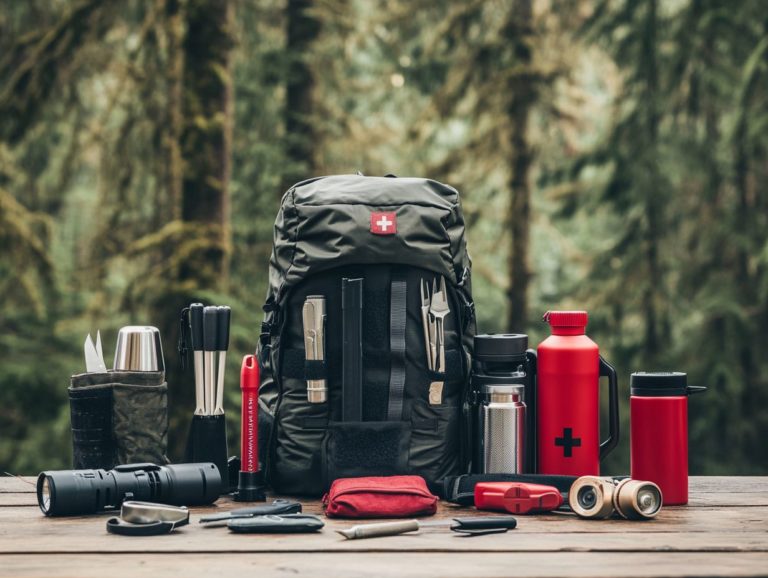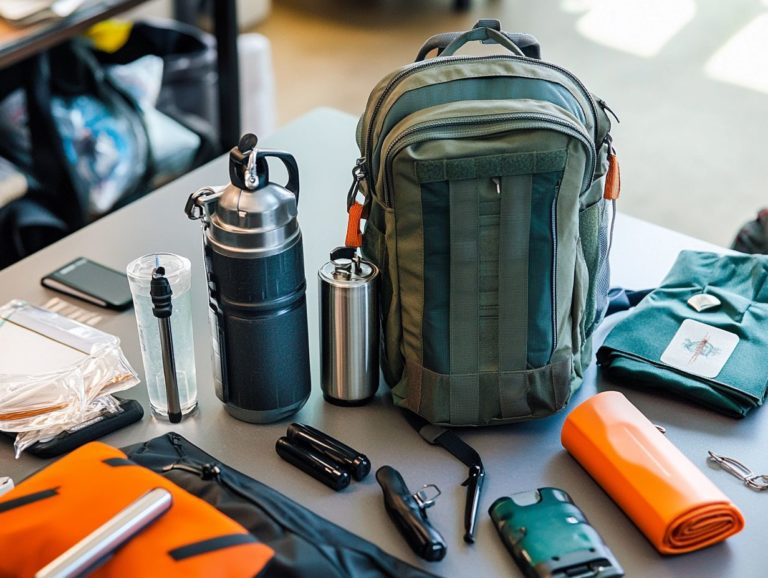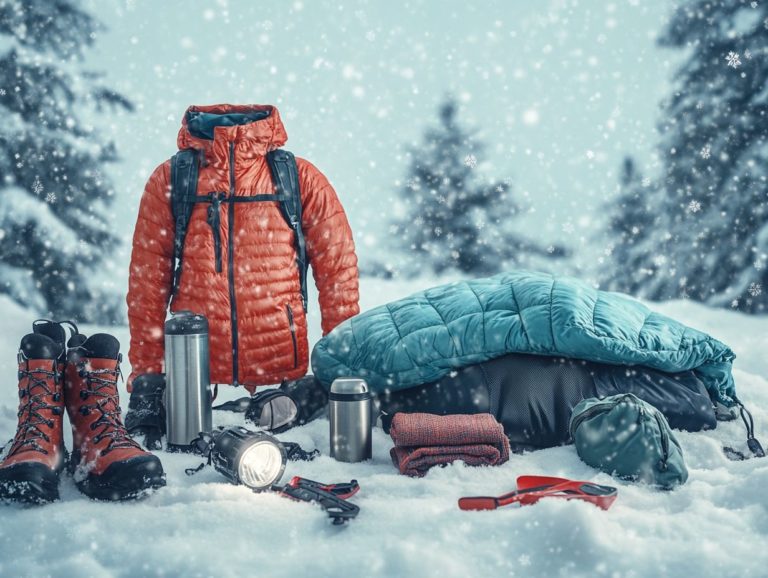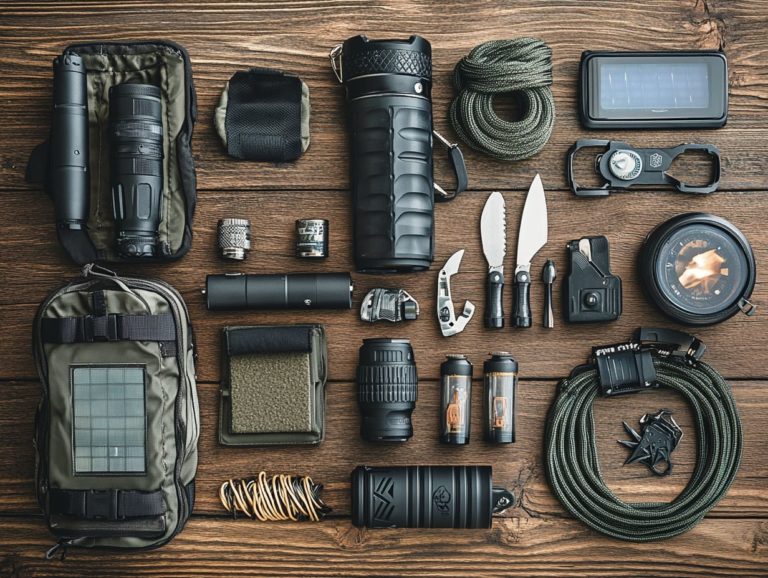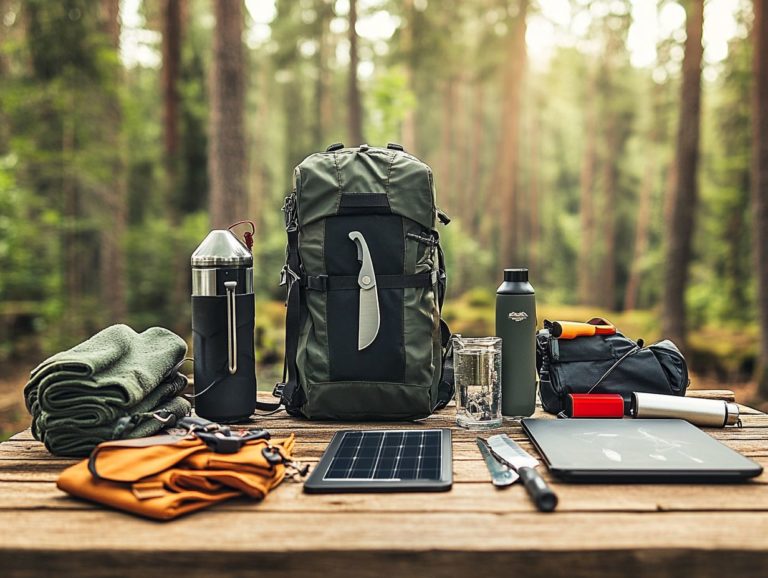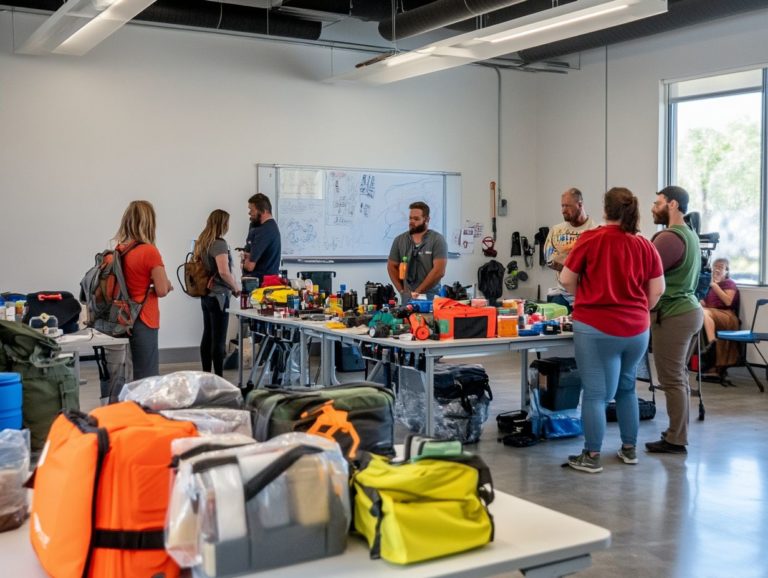Essential Tools for Your Survival Gear Kit
In a world where unpredictability is the norm, your preparedness can truly set you apart.
Whether you’re facing natural disasters, going on outdoor adventures, or dealing with unexpected emergencies, having the right survival gear is vital.
This article highlights crucial items to include in your kit, from water filters to first aid supplies, ensuring you’re equipped to handle any situation that arises. You’ll also discover tips for selecting the right gear, pitfalls to avoid, and skills to boost your preparedness.
Continue reading to learn how to stay ready and confident in any scenario life throws at you.
Contents
- Key Takeaways:
- 1. Water Filter
- 2. Emergency Shelter
- 3. Multi-Tool
- 4. Fire Starter
- 5. First Aid Kit
- 6. Navigation Tools
- 7. Emergency Food Supply
- 8. Personal Protection Equipment
- 9. Communication Devices
- 10. Lighting Tools
- 11. Hygiene Supplies
- 12. Repair Kit
- 13. Self-Defense Weapons
- 14. Solar Charger
- 15. Emergency Whistle
- What Are the Most Important Items to Include in a Survival Gear Kit?
- Frequently Asked Questions
- What are the essential tools for a survival kit?
- Why is it important to have a survival kit?
- Do I need to invest in expensive tools for my survival kit?
- How often should I check and update my survival kit?
- Can I customize my own survival kit?
- Are there any items that are commonly overlooked in a survival kit?
Key Takeaways:
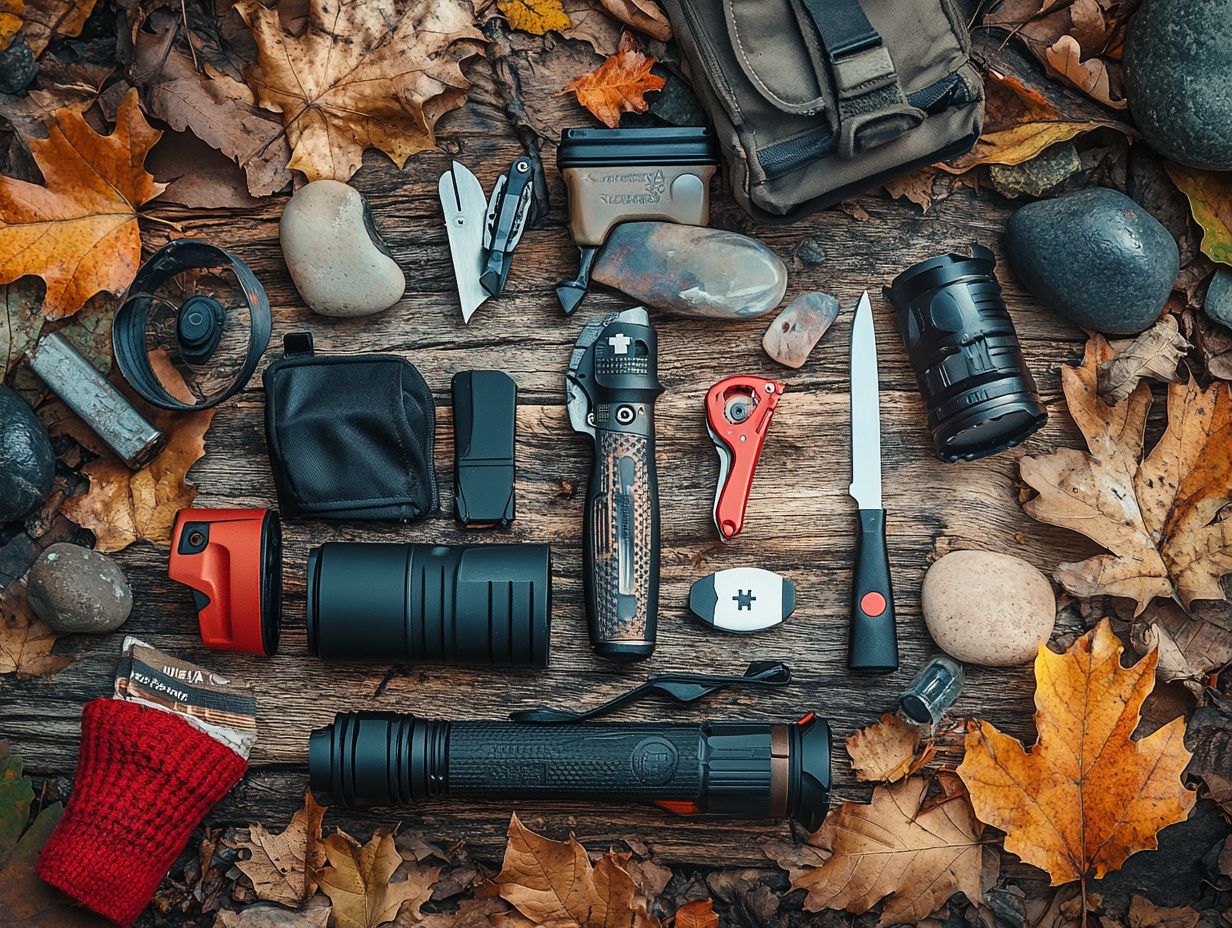
- A water filter is crucial for clean drinking water during emergencies.
- A multi-tool provides versatility and utility for various survival tasks.
- Personal protective equipment, like gloves and masks, should be included in your survival kit for added safety, along with a survival knife for protection.
1. Water Filter
A reliable water filter is essential for your survival kit. It ensures you have access to clean drinking water during outdoor emergencies and wilderness scenarios. With tools like the Katadyn Micropur, you can purify water and protect yourself against harmful contaminants.
Investing in a quality water filter is crucial for your survival priorities, especially in remote areas where clean water is scarce. Various types of water filters are available, each designed for specific needs. For instance, gravity filters are excellent for groups, while portable filters fit easily into your backpack for solo journeys.
If you find yourself without a filter, chemical treatments like iodine tablets offer a lightweight and long-lasting solution for purifying water. Integrating a reliable water bottle with built-in filters into your gear enhances your hydration strategy during outdoor adventures.
This versatility not only ensures safe drinking water but also highlights hydration’s vital role in maintaining your energy levels and mental clarity both essential for survival in challenging environments.
2. Emergency Shelter
An emergency shelter is your lifeline against the elements during outdoor emergencies. It acts as a waterproof refuge that can significantly enhance your chances of survival. Using materials like plastic sheeting or a solar blanket, you can build a shelter that keeps you dry and warm while you await rescue or plan your next move.
Beyond basic options, you have a variety of emergency shelters, from quickly deployable tents to innovative improvised solutions like a lean-to made from branches and leaves. The right materials such as tarps, rope, and insulation can make a significant difference in your shelter’s effectiveness.
Proper insulation is vital for maintaining warmth and shielding against wind. This transforms shelters from mere temporary fixes into essential components of your survival strategy. A well-constructed waterproof shelter not only protects you from harsh weather but also plays a crucial role in maintaining morale and ensuring long-term survival.
Start building your survival kit today your safety depends on it!
3. Multi-Tool
A multi-tool is an essential item in your survival kit, offering a range of functionalities that can assist you in various wilderness situations, whether you re building a shelter or preparing a meal. Tools like the Leatherman or a robust fixed-blade knife serve as vital survival gear, providing the versatility you need to address unexpected challenges in the wild.
Picture yourself stranded in the wilderness with only minimal resources. In such scenarios, a multi-tool can truly be a game-changer. With features like pliers, screwdrivers, and can openers, it significantly enhances your ability to make quick repairs or adjustments to gear that might otherwise impede your survival efforts.
For instance, if a sudden downpour hits, your multi-tool can help you create a makeshift tarp system or swiftly mend broken equipment. Meanwhile, a knife becomes invaluable for cutting sturdy branches or preparing food. Together, these essentials form a formidable toolkit that boosts your chances of survival, especially when you have the top survival tools for emergency preparedness to ensure you’re well-prepared for the unpredictable nature of the wild.
4. Fire Starter
A reliable fire starter is critical for your survival kit. Creating fire can make a big difference in your survival, providing warmth, cooking options, and a vital way to signal for help. Tools like the magnesium block and firebiner streamline the ignition process, enabling you to spark a flame even when conditions are less than ideal. This enhances your overall survival strategy and makes you feel secure.
In wilderness survival scenarios, grasping various fire-starting methods is crucial. Beyond the traditional matches and lighters, techniques like flint and steel, bow drill, or even a fire starter gel a special gel that helps ignite fires easily can prove essential to your success.
Once you have a fire going, it s not just about staying warm. Fire serves multiple purposes, such as cooking food and purifying water, both vital for your health and well-being. Knowing how to use these tools properly helps treat injuries quickly.
Safety is paramount when it comes to managing fire. Always establish a controlled environment by clearing away flammable debris and keeping a bucket of water or dirt close at hand for when it s time to extinguish the flames.
This knowledge can literally save your life in the wild, particularly when using items like a signal mirror which reflects sunlight to attract attention for rescue or assistance.
5. First Aid Kit
A well-stocked first aid kit is the cornerstone of your survival gear, enabling you to address injuries or illnesses that may arise during your wilderness adventures. Having the right supplies can indeed be the difference between life and death, equipping you to handle everything from minor cuts to serious emergencies that demand immediate attention.
It s essential to include adhesive bandages, antiseptic wipes, gauze pads, and medical tape in your kit to treat abrasions and prevent infections effectively. Adding items like pain relievers, tweezers, and scissors allows you to manage various situations with efficiency. Knowing how to properly utilize these tools ensures that injuries are treated promptly and correctly, significantly impacting recovery.
Don t underestimate the value of an emergency whistle; in situations where quick communication is crucial, it can alert those nearby and potentially summon help for anyone in distress.
Effective navigation tools are essential for your wilderness survival, helping you navigate unfamiliar terrain and prioritize your safety. A topographic map which shows the shape of the land and helps you find your way can be your best friend in challenging landscapes, steering you clear of getting lost and allowing you to orient yourself as you plan your route.
When enhanced with the right tools, such as compasses and GPS devices, navigating the wild transforms from an overwhelming challenge into a manageable task. Understanding how these instruments function is key; for example, compasses offer you reliable direction, while GPS devices provide precise locations with remarkable ease.
It s crucial to familiarize yourself with reading topographic maps, taking note of contour lines that indicate elevation changes and recognizing natural landmarks like rivers and mountains, which serve as dependable reference points. This foundational knowledge not only aids you in route planning but also boosts your confidence in traversing unfamiliar landscapes.
7. Emergency Food Supply
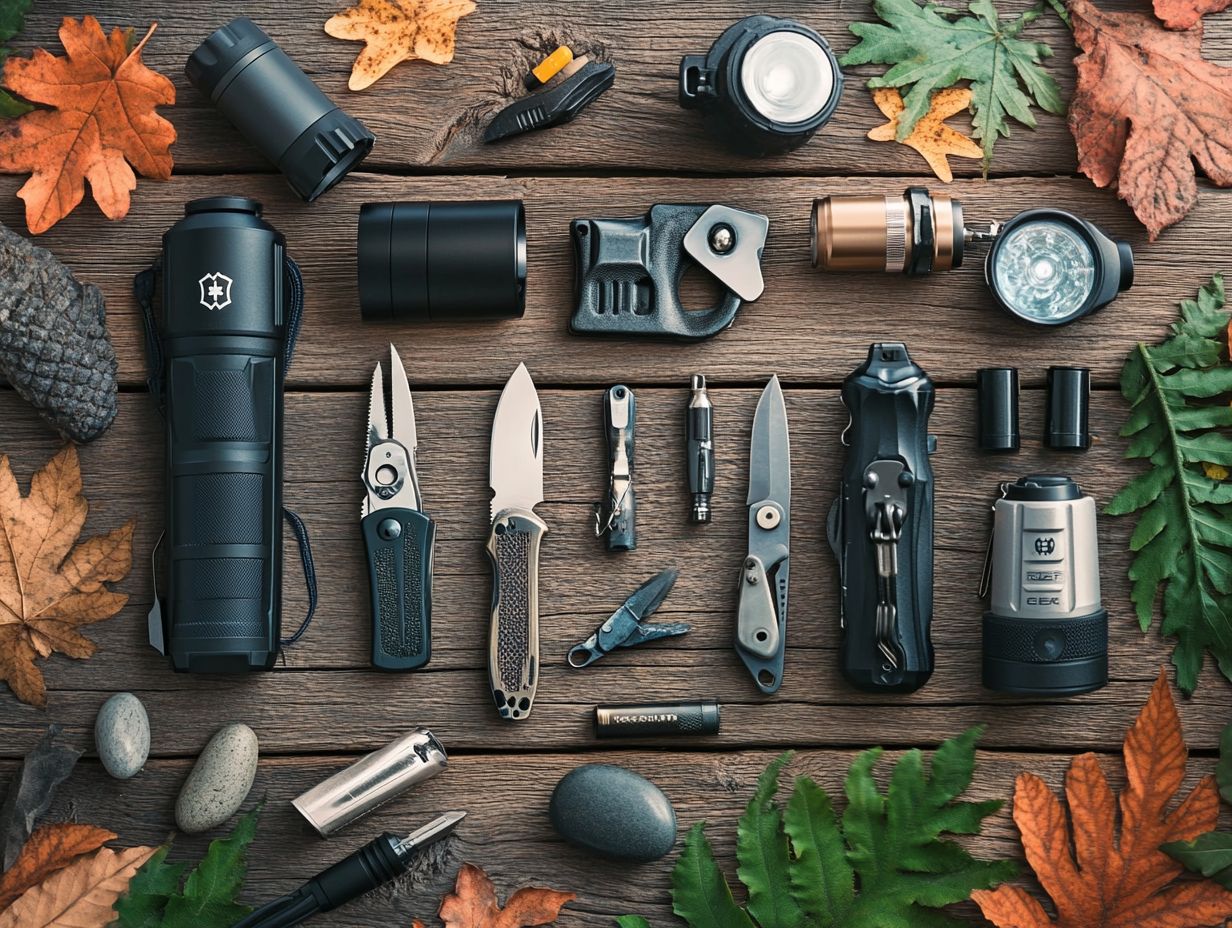
An emergency food supply is crucial for maintaining your energy levels during wilderness survival situations. It ensures you can stay strong and focused when faced with challenges.
By preparing a stock of non-perishable food items foods that don’t spoil quickly you greatly increase your chances of surviving unexpected scenarios. This preparation allows you to remain self-sufficient until help arrives.
When considering what to include in your supply, lean towards high-energy options that are lightweight and easy to prepare. Think energy bars, dried fruits, nuts, and freeze-dried meals. These items provide vital nutrients without weighing you down with cumbersome packaging.
Equally important are the skills you ll need to source food in the wild. Knowing how to identify edible plants or catch fish can greatly enhance your supplies.
Places like Bear Grylls Adventure Park offer invaluable hands-on training experiences. You can master these essential survival skills in a simulated environment, equipping yourself for real-life adventures.
8. Personal Protection Equipment
Personal protection equipment is an essential component of your survival gear. It enables you to shield yourself from potential threats and maintain your safety in unpredictable environments.
This could include items such as a survival knife, self-defense weapons, and clothing tailored for rugged conditions.
As you embark on various wilderness adventures, assessing the specific risks at hand is crucial. Each scenario may require its own unique set of gear.
For example, if you re hiking in bear territory, you might need bear spray a special spray to deter bears and noise-making devices. If navigating dense foliage, more durable clothing can prevent injuries.
Self-defense knowledge is crucial as well. Understanding how to effectively use your gear can significantly bolster your personal security.
Make sure to assess your individual needs, experience levels, and the specific environments you ll encounter. This careful consideration will help you select the most suitable protective items, ensuring a comprehensive approach to safety in the great outdoors.
9. Communication Devices
Communication devices are absolutely vital for staying connected with the outside world during survival situations. They serve as your lifeline in backcountry emergencies.
Options like a SPOT locator and an emergency whistle can dramatically enhance your chances of being located and rescued when you need it most.
In survival situations, every second counts! Grasping the range of signaling methods can make all the difference. Utilizing technology such as satellite phones or emergency beacons not only boosts the likelihood of receiving prompt assistance but also provides a greater sense of security in remote areas.
Don t underestimate traditional methods either; smoke signals and reflective surfaces still hold their own and can beautifully complement modern devices. Each method can shine depending on your environment, illustrating the versatility of your toolkit.
Ultimately, being well-equipped with a blend of these tools ensures that you can effectively communicate your distress. This significantly improves your chances of survival.
10. Lighting Tools
Lighting tools are essential components of your survival kit, offering crucial illumination in dark conditions. They can make all the difference in safe navigation and constructing a waterproof shelter.
From flashlights to lanterns, having dependable lighting tools elevates your wilderness survival skills. It allows you to tackle tasks effectively after the sun sets.
Among the myriad options available, battery-operated lights stand out for their portability and consistent brightness. This makes them a go-to choice for many adventurers like yourself. On the flip side, solar-powered tools bring an impressive sustainability factor, harnessing natural energy to keep you lit without the hassle of frequent battery changes.
Both types of lighting serve vital roles. They ensure visibility and boost morale during those challenging moments in the wild. Adequate lighting can help prevent accidents, deter potential threats, and provide a comforting glow all key elements that contribute to a successful survival experience.
11. Hygiene Supplies
Maintaining good hygiene supplies in your survival gear is essential for preventing infections and ensuring your overall health during wilderness survival situations. Good hygiene shields you from illness and keeps you safe and healthy, positioning it as a necessary component alongside your first aid kit and other vital essentials.
During extended outdoor expeditions, a well-rounded selection of hygiene products becomes even more critical. Essential hygiene supplies include:
- Soap for hand cleansing.
- Hand sanitizer when water isn t available.
- Sanitary products.
These supplies help mitigate the risks associated with dirt and bacteria. When you re living in close quarters with others or when resources are limited, maintaining cleanliness can significantly impact your health, warding off common ailments. They play a crucial role in ensuring safe practices that protect both you and your companions from more serious health issues down the line.
12. Repair Kit
A comprehensive repair kit is an often-overlooked yet essential element of your survival gear. It enables you to fix broken equipment and maintain the functionality of your gear when emergencies strike. Items like paracord, which is a strong type of rope, can be invaluable for quick repairs.
Including handy tools such as multi-tools, duct tape, and a small assortment of screws and nails can truly transform your capabilities, enabling a broader range of repairs. Picture a scenario where a tent pole snaps during a storm; with a well-equipped kit in hand, those critical moments of struggle can be significantly minimized. For more insights, check out how to choose the right survival gear for you. This saves you precious time and energy for navigating other survival challenges.
A complete repair kit gets you ready for surprises, lessening the need for costly replacements and ensuring that all your resources are utilized effectively.
13. Self-Defense Weapons
Self-defense weapons are an essential consideration in wilderness survival, offering you a means to protect yourself against potential threats, whether from wildlife or other humans. A well-selected survival knife is invaluable, serving dual purposes as both a versatile tool and a self-defense weapon.
Beyond knives, you might also consider options like pepper spray, which can be particularly effective in close encounters, or a collapsible baton, providing both reach and convenience for carrying.
The choice of the right weapon often depends on your personal comfort and level of training, making it vital for you to familiarize yourself with the various types available before making a decision. Know the local laws about these weapons. They vary from place to place, and this knowledge will influence your choices and the potential legality of your options.
14. Solar Charger
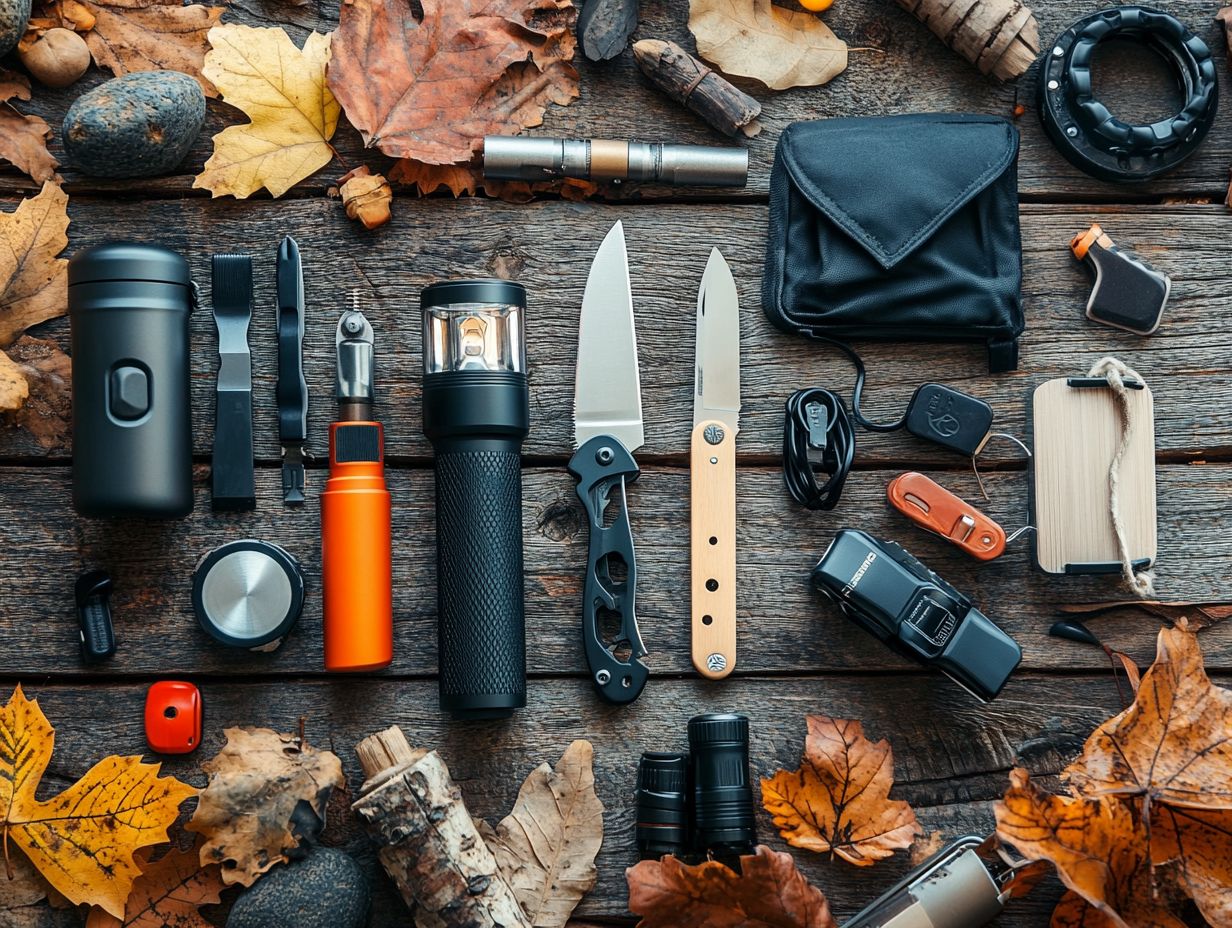
A solar charger is a critical asset for your survival kit, enabling you to keep essential devices charged during extended wilderness adventures. This sustainable energy source proves particularly beneficial for powering lighting tools, communication devices, and GPS devices, ensuring you stay connected and prepared for whatever may come your way.
You ll find a variety of solar chargers tailored to meet diverse needs ranging from compact portable panels perfect for backpackers to larger, foldable models designed for families. These chargers harness the sun’s energy while offering versatility for different applications, such as powering portable fridges or charging batteries for survival radios.
In today’s survival scenarios, where remaining connected can make the difference between safety and disaster, using solar energy lets you stay powered up and ready for anything! This capability to generate electricity makes solar chargers an essential tool for anyone aiming to elevate their survival strategies, especially when you know what to include in your survival gear kit.
15. Emergency Whistle
An emergency whistle is a critical addition to your survival gear. This lightweight yet powerful tool is designed to attract attention and signal for help in crucial situations. Its piercing sound can carry over long distances, making it an exceptionally effective method for signaling that could significantly enhance your chances of being rescued during backcountry emergencies.
Today s market offers a diverse range of emergency whistles to suit various needs and environments. You can choose from basic plastic models to more robust metal options that provide enhanced durability and louder volume. In scenarios like getting lost in the wilderness or facing a natural disaster where shouting can quickly drain your energy or prove ineffective a whistle allows for rapid, repeated signaling without straining your voice.
As you prepare for outdoor adventures, incorporating an emergency whistle into your survival kit, alongside essentials like first-aid supplies and navigation tools, equips you with a comprehensive strategy to tackle unexpected challenges effectively. Don’t forget to check out the top 10 survival gear for wilderness adventures to ensure you’re fully prepared.
What Are the Most Important Items to Include in a Survival Gear Kit?
When you’re preparing a survival gear kit, focus on the essential items that can dramatically improve your chances of thriving in wilderness situations. Key components include a water filtration system which helps remove impurities from water emergency shelter, first aid kit, and reliable signaling methods. Choose these based on your unique survival needs and the specific backcountry emergencies you might face.
Each item in your kit should be tailored to the environmental conditions you expect to encounter, whether that’s extreme cold, heavy rainfall, or challenging terrain. For example, a compact, lightweight tarp is critical in wet climates, while a high-quality sleeping bag is a must-have for colder environments. Additionally, knowing the top features to look for in survival gear can help you make informed choices.
Don’t overlook the value of versatile tools like a multi-tool—a device that combines several tools in one, like knives and screwdrivers—or a knife, as they can perform a variety of tasks. Understanding the importance of survival gear allows you to personalize your kit to meet your individual survival needs and helps to mitigate risks specific to different regions.
This attention to detail can make a life-saving difference when time is of the essence! It ultimately enhances your overall preparedness and boosts your confidence when confronting unexpected challenges.
How Can One Choose the Right Survival Gear for Their Needs?
Choosing the right survival gear tailored to your specific needs requires a thoughtful assessment of your environment, skill level, and personal priorities in wilderness scenarios. Whether you re diving into a wilderness survival class or gearing up for solo adventures, understanding the unique challenges you might encounter can significantly influence your gear selection.
Factors such as climate conditions, terrain type, and the duration of your trip can greatly affect the tools you decide to take. For instance, if you re heading into a damp, chilly environment, prioritizing waterproof gear is a must. Conversely, for a longer expedition, lightweight and multifunctional equipment becomes essential.
Your personal experience also plays a pivotal role in this process. A novice might find user-friendly items more appealing, while seasoned adventurers could gravitate toward advanced survival tools. When selecting gear, weigh its functionality against its weight. Opt for equipment that serves its purpose without adding unnecessary bulk, allowing you to navigate the wilderness with confidence and ease.
What Are Some Common Mistakes to Avoid When Building a Survival Gear Kit?
When you set out to build a survival gear kit, it’s easy to fall into common traps that could endanger your safety in wilderness scenarios. Overlooking versatile, high-quality items or ignoring essential components can leave you unprepared for backcountry emergencies.
To truly elevate your readiness, focus on quality over quantity. Many mistakenly think that cramming a bag full of items guarantees safety, but this strategy often backfires.
Take the time to research reputable brands and consult with outdoor experts to unveil insights you might otherwise miss. Connecting with seasoned survivalists can clarify which tools are truly critical, transforming your kit into a dependable resource.
Ultimately, grasping the importance of thoughtful selection enables you to craft a more effective survival strategy. This gives you the confidence to tackle even the toughest situations. Don’t wait! Start building your survival kit today to ensure you’re ready for any wilderness challenge with the help of the essential guide to survival gear maintenance!
How Often Should One Update Their Survival Kit?
Regularly updating your survival kit is essential to maintain how well it works and to ensure it meets your changing wilderness survival needs and skills. Monitor factors like the expiration dates of food and medical supplies, advancements in gear technology, and your own personal experiences to guide your reviews and updates.
Establish a consistent schedule for these reviews to be prepared for unexpected emergencies or wilderness outings. As you gain new insights or skills from various experiences, regularly check and adjust your kit to stay ready.
Specific items, such as water purification tools to make water safe to drink and:
- water purification systems
- non-perishable food
- first aid supplies
- navigation tools including basic celestial navigation tools.
Your list may need updates to reflect the latest standards or your personal preferences. Consider referring to a comprehensive survival gear checklist for outdoor enthusiasts and look back at past experiences to find what your kit may be missing, ensuring you are fully equipped to handle any situation that may arise.
What Are Some Essential Skills to Have in Addition to a Survival Kit?
Along with having a well-equipped survival kit, possessing essential skills is equally critical for effective wilderness survival and managing backcountry emergencies. Skills like fire-building, navigation, and first aid enhance your self-sufficiency and help you prioritize your actions in survival situations.
Mastering techniques such as shelter construction, water purification, and foraging can prove invaluable. These skills enable you to be proactive rather than reactive during unexpected challenges. For instance, if the weather turns harsh or a hiking route becomes treacherous, having survival skills can significantly increase your chances of safety and comfort.
It s not merely about owning the right tools; the confidence gained from practical training and consistent practice empowers you to tackle problems with a clear mind. Engaging in workshops or courses is an excellent way for both enthusiasts and adventurers to sharpen their abilities, ensuring resilience in the great outdoors.
Frequently Asked Questions
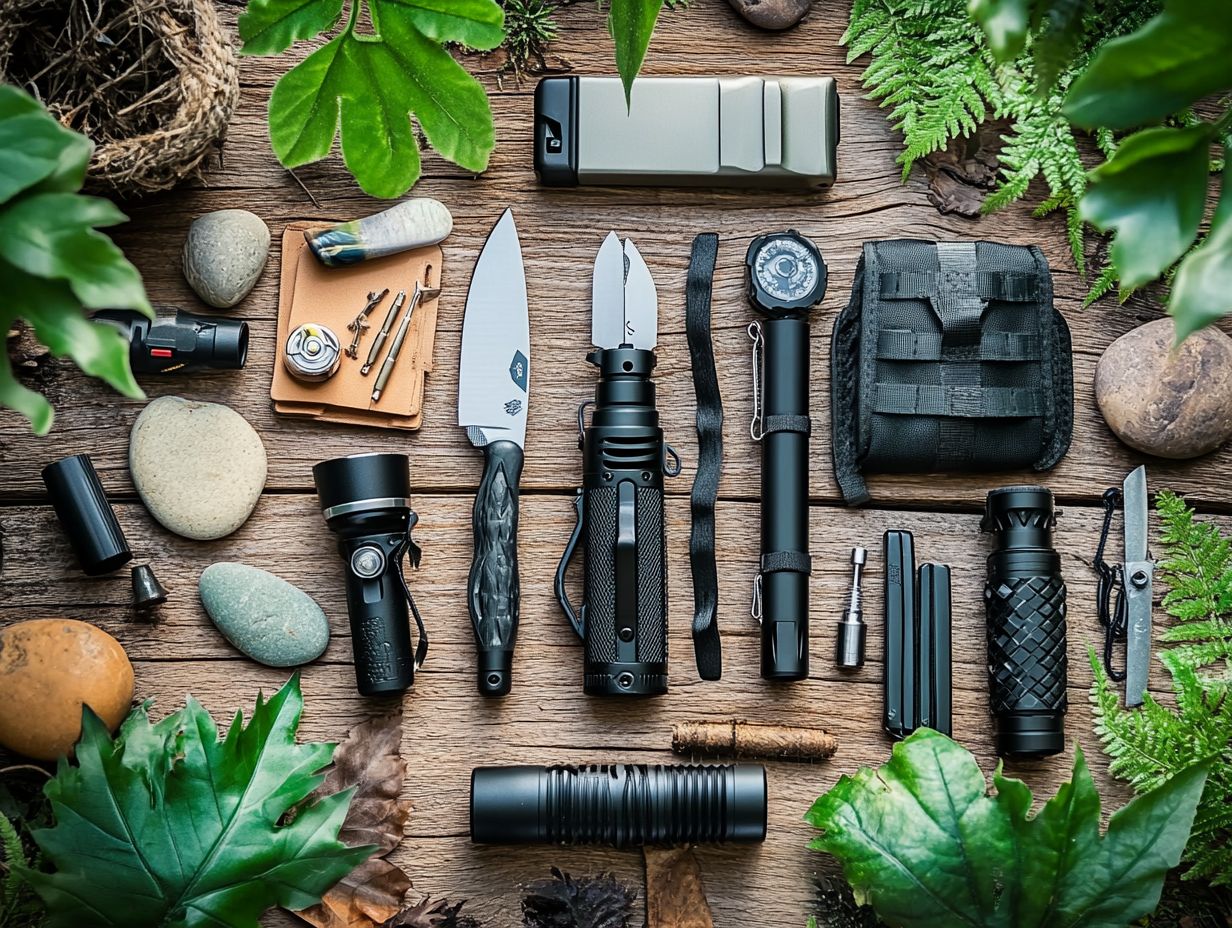
What are the essential tools for a survival kit?
The essential tools for a survival kit vary depending on the situation and personal preference. Common items include a knife, fire-starting tools, shelter materials, first aid supplies, a water filtration system, and a compass.
Why is it important to have a survival kit?
A survival kit can be a lifesaver in emergency situations, providing you with the necessary tools and supplies to survive until help arrives. It is crucial to be prepared for unexpected situations, especially when venturing outdoors.
Do I need to invest in expensive tools for my survival kit?
No, you do not necessarily need to invest in expensive tools for your survival kit. Many affordable options are available that are still high quality and reliable. It is important to research and choose items that best fit your needs and budget.
How often should I check and update my survival kit?
It is recommended to check and update your survival kit every 6-12 months or whenever you use it. This ensures that all items are in working condition and not expired. Regularly assess and add items based on your personal needs and potential emergency scenarios.
Can I customize my own survival kit?
Yes, you can definitely customize your own survival kit to fit your specific needs and preferences. This may include adding or removing items based on the environment you will be in, the duration of your trip, and any potential emergencies you may encounter.
Are there any items that are commonly overlooked in a survival kit?
Some commonly overlooked items in a survival kit include a signaling device such as a whistle or mirror, and a multi-tool for various tasks. Think about all possible scenarios and pack accordingly to ensure you are fully prepared in an emergency situation.
Start reviewing your kit today to ensure your safety in any situation!

